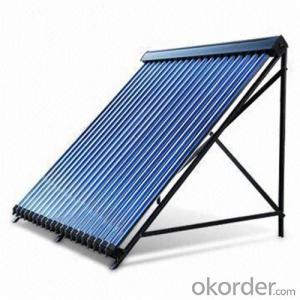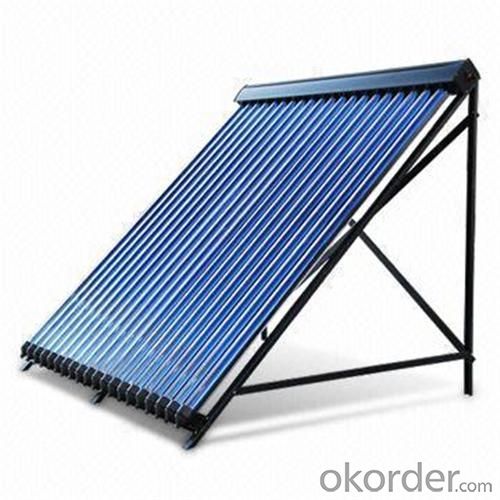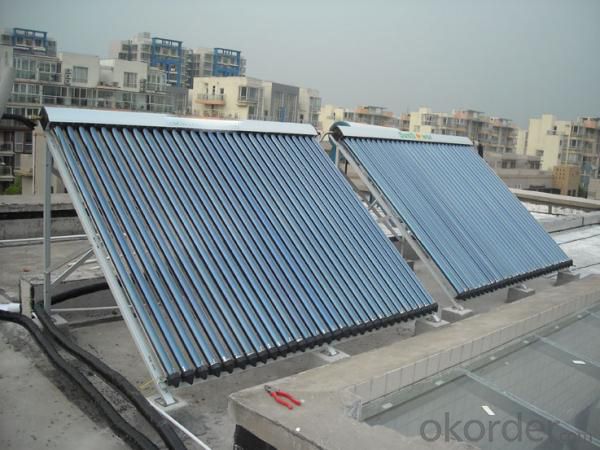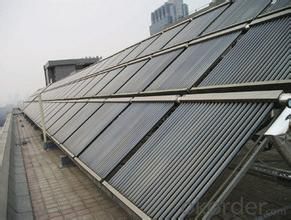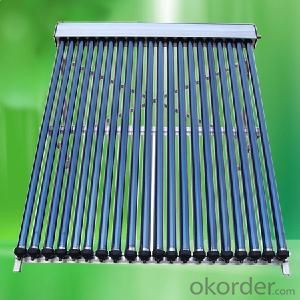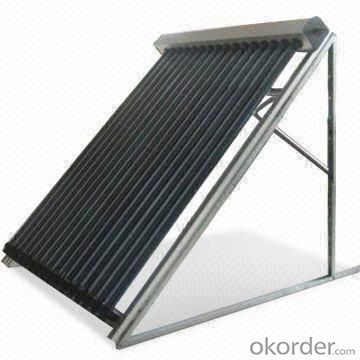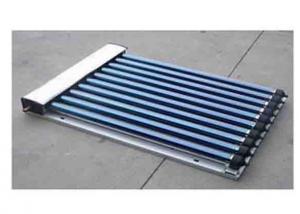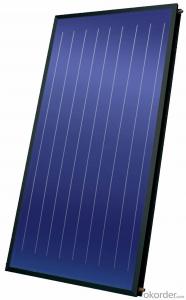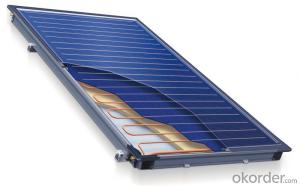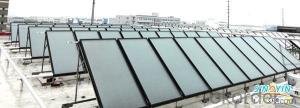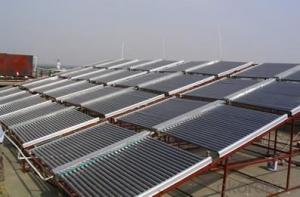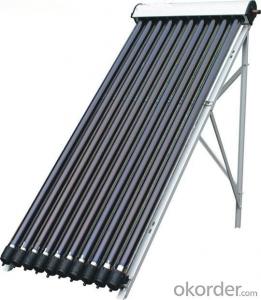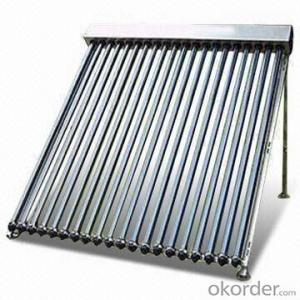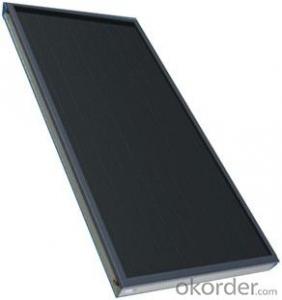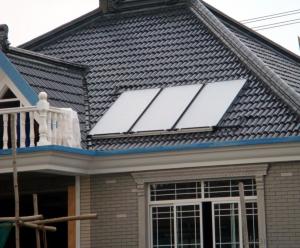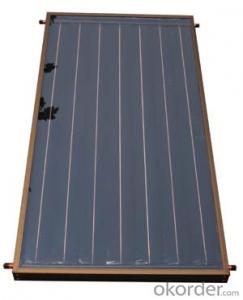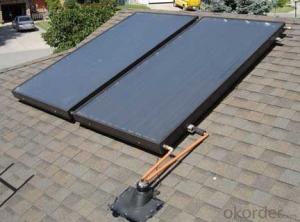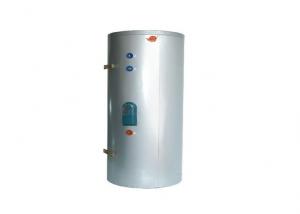Pier Solar Collectors Edition - Pressurized Heater Pipe Solar Collectors for Rooftop
- Loading Port:
- China main port
- Payment Terms:
- TT OR LC
- Min Order Qty:
- 5 set
- Supply Capability:
- 10000 set/month
OKorder Service Pledge
OKorder Financial Service
You Might Also Like
Specifications
manifold (inner) | red copper |
manifold (exterior) | aluminum alloy |
glass tube dimensions | 58mm * 1800mm |
daily efficiency | ≥55% |
heat preservation | 72 hours |
hail resistance | 25mm |
max pressure | 7 bar |
coating of vacuum tube | ALN/AIN-SS/CU |
heat pipe | anti-freezing > -35 degree |
certificate | Solar Keymark, EN12975,SRCC |
Serious Product
Models | L*W*H mm | Vacuum tube | Power output | Efficiency | Header mm | Frame | container loading 20FT/40HQ sets | Gross Weight kg |
SHC-8 | 1917*910*133 | 58*1800*8pcs | 939W | 0.668 | Φ35/1.0 | AL alloy | 185/445 | 27 |
SHC-10 | 1917*1130*133 | 58*1800*10pcs | 1189W | 159/385 | 33 | |||
SHC-12 | 1917*1350*133 | 58*1800*12pcs | 1440W | 149/358 | 40 | |||
SHC-15 | 1917*1680*133 | 58*1800*15pcs | 1815W | 120/290 | 49 | |||
SHC-18 | 1917*2010*133 | 58*1800*18pcs | 2191W | 100/242 | 59 | |||
SHC-20 | 1917*2230*133 | 58*1800*20pcs | 2442W | 87/210 | 66 | |||
SHC-22 | 1917*2450*133 | 58*1800*22pcs | 2692W | 83/202 | 72 | |||
SHC-24 | 1917*2670*133 | 58*1800*24pcs | 2943W | 77/188 | 79 |
Packaging & Delivery
Packaging Details: | Exporting Carton with big foaming protection |
Delivery Detail: | In 10-15 days |
Loading Quantity
Model | Tube | Tube Q.T.Y | Loading Q.T.Y/40HQ |
GSC15 | 58*1800mm | 15pcs | 315sets |
GSC18 | 58*1800mm | 18pcs | 265sets |
GSC20 | 58*1800mm | 20pcs | 248sets |
GSC22 | 58*1800mm | 22pcs | 225sets |
GSC25 | 58*1800mm | 25pcs | 200sets |
GSC30 | 58*1800mm | 30pcs | 168sets |
Principle of solar collector:
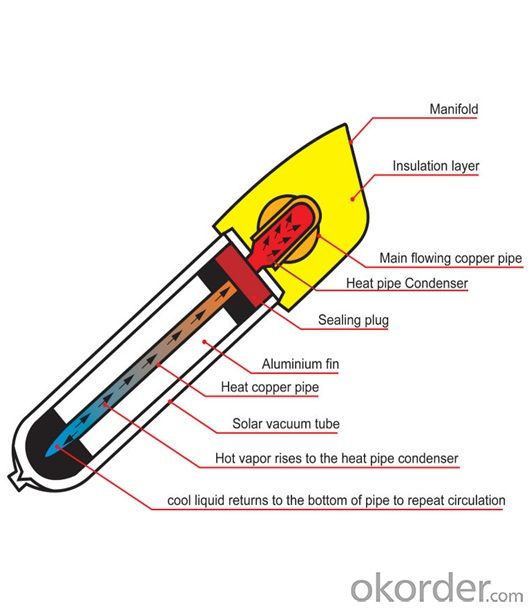

Solar collector details
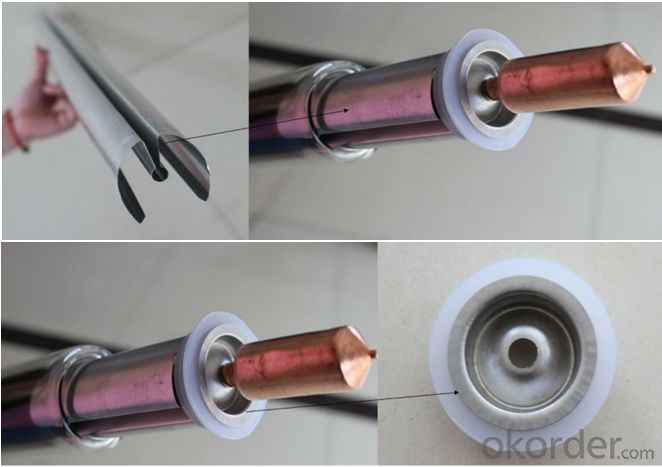

- Q: Can solar collectors be used for drying household appliances?
- No, solar collectors cannot be used for drying household appliances. Solar collectors are designed to capture and convert sunlight into heat energy, which can then be used for heating water or generating electricity. They are not suitable for drying household appliances as the heat generated by solar collectors is typically not high enough to effectively dry appliances. Household appliances such as clothes dryers require a much higher temperature and specific airflow to efficiently dry clothes or other items. Therefore, alternative methods such as air drying or using specialized drying appliances would be more suitable for drying household appliances.
- Q: Are solar collectors suitable for heating livestock buildings?
- Yes, solar collectors are suitable for heating livestock buildings. They can provide a cost-effective and environmentally friendly solution for heating, ensuring a comfortable temperature for the animals while reducing energy costs and dependence on fossil fuels.
- Q: Can solar collectors be used for heating tennis courts?
- Yes, solar collectors can be used for heating tennis courts. By harnessing the sun's energy, solar collectors can generate heat that can be used to warm the tennis court surface, enabling players to enjoy the game in colder weather conditions.
- Q: Are there any drawbacks to using solar collectors?
- Yes, there are a few drawbacks to using solar collectors. Firstly, solar collectors can be expensive to install and maintain, making them less affordable for some individuals or businesses. Additionally, solar collectors are dependent on sunlight, so they are less efficient in areas with limited sunlight or during cloudy days. Moreover, solar collectors require a considerable amount of space for installation, which can be a challenge in densely populated areas. Finally, the production of solar panels involves the use of materials that have environmental impacts, although these impacts are generally lower than those associated with fossil fuel energy sources.
- Q: How much energy can solar collectors generate?
- Solar collectors can generate a significant amount of energy if properly designed and utilized. The amount of energy that solar collectors can generate depends on several factors such as the size and efficiency of the collectors, the available sunlight, and the location of the collectors. On average, solar collectors can generate around 1,000 kilowatt-hours (kWh) of electricity per year for every square meter of collector area in ideal conditions. However, this can vary widely depending on geographical location and weather patterns. In regions with abundant sunlight and minimal shading, solar collectors can generate even more energy. For example, in sunny regions like the southwestern United States, solar collectors can generate up to 2,000 kWh per year for every square meter of collector area. It is important to note that solar collectors not only generate electricity but can also produce hot water for residential or commercial use. The amount of hot water that solar collectors can generate depends on the size of the system and the specific needs of the user. In conclusion, solar collectors have the potential to generate a significant amount of energy, ranging from 1,000 to 2,000 kWh per year per square meter of collector area. This renewable energy source can contribute to reducing reliance on fossil fuels and mitigating the impact of climate change.
- Q: Can solar collectors be used for heating residential care facilities?
- Yes, solar collectors can be used for heating residential care facilities. Solar thermal systems can efficiently capture and convert sunlight into heat energy, which can then be used for space heating, water heating, and even heating swimming pools in residential care facilities. Implementing solar collectors can help reduce energy costs and carbon emissions, making it a sustainable and environmentally friendly solution for heating these facilities.
- Q: Can solar collectors be used in remote areas without access to the grid?
- Yes, solar collectors can be used in remote areas without access to the grid. Solar collectors, such as solar panels, can generate electricity by harnessing the sun's energy. This makes them an ideal solution for remote areas where grid access is limited or nonexistent. By converting sunlight into electricity, solar collectors can provide a sustainable and reliable power source in these remote locations.
- Q: Can solar collectors be used for heating hot tubs?
- Yes, solar collectors can be used for heating hot tubs. Solar thermal collectors are designed to capture and convert solar energy into heat, which can then be used to warm water in hot tubs. This eco-friendly and cost-effective method of heating utilizes the sun's energy to raise the temperature of the water, providing a sustainable and efficient solution for heating hot tubs.
- Q: Are solar collectors suitable for museums and art galleries?
- Yes, solar collectors are suitable for museums and art galleries. Solar collectors, also known as solar panels or photovoltaic systems, convert sunlight into electricity which can be used to power various electrical devices and systems within the museum or art gallery. There are several reasons why solar collectors are suitable for these establishments. Firstly, museums and art galleries often have large roofs or open spaces where solar panels can be installed, allowing for maximum exposure to sunlight. This is crucial for generating sufficient electricity to meet the energy demands of the building. Secondly, museums and art galleries are typically open during the day, which coincides with the peak availability of sunlight. This means that solar collectors can efficiently harness the sun's energy and provide a reliable source of electricity throughout the day. Moreover, museums and art galleries often prioritize environmental sustainability and energy efficiency. Installing solar collectors aligns with these goals by reducing the reliance on fossil fuels and decreasing the carbon footprint of the establishment. It showcases the institution's commitment to renewable energy and sets an example for visitors and the wider community. Additionally, solar collectors can help museums and art galleries save on energy costs in the long run. While the initial investment may be higher, the electricity generated from solar panels is essentially free once the system is installed and operational. This can result in significant savings on utility bills over time. Furthermore, the use of solar collectors can enhance the reputation and public image of museums and art galleries. It demonstrates a forward-thinking approach to energy consumption and environmental responsibility, which can attract environmentally conscious visitors and donors. In conclusion, solar collectors are highly suitable for museums and art galleries due to their ability to generate clean and renewable electricity, their compatibility with the operating hours of these establishments, their potential for cost savings, and their positive impact on the institution's image. By embracing solar energy, museums and art galleries can contribute to a more sustainable future while maintaining their commitment to preserving and displaying cultural heritage.
- Q: Can solar collectors be installed on a flat roof?
- Yes, solar collectors can be installed on a flat roof. In fact, flat roofs are often ideal for solar panel installations because they provide ample space and easy access for mounting the collectors.
Send your message to us
Pier Solar Collectors Edition - Pressurized Heater Pipe Solar Collectors for Rooftop
- Loading Port:
- China main port
- Payment Terms:
- TT OR LC
- Min Order Qty:
- 5 set
- Supply Capability:
- 10000 set/month
OKorder Service Pledge
OKorder Financial Service
Similar products
Hot products
Hot Searches
Related keywords
